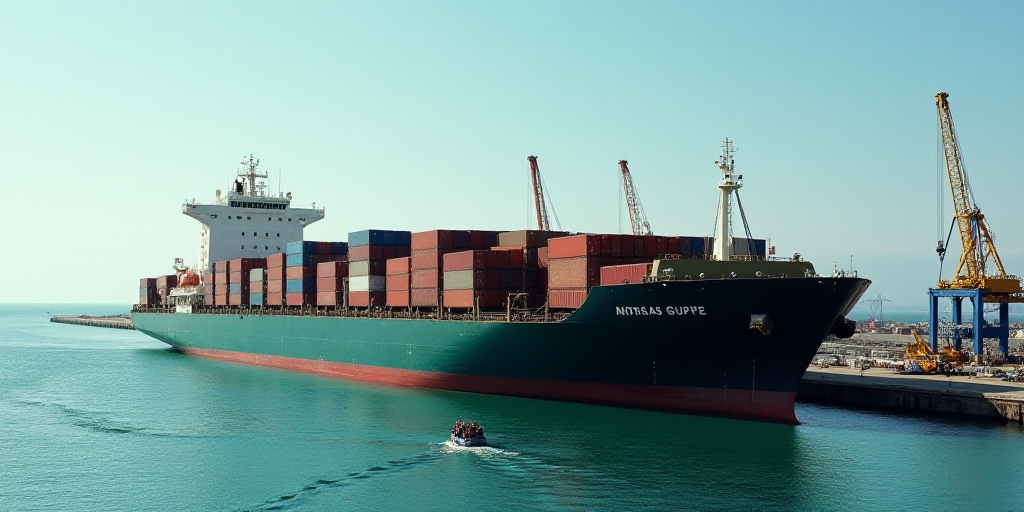Background on UNCTAD and its Relevance
The United Nations Conference on Trade and Development (UNCTAD) is a crucial United Nations body dedicated to enhancing the understanding of global economic issues and promoting trade among nations. Its projections on maritime trade growth significantly impact international shipping industries, governments, and businesses.
Maritime Trade Growth Projections
According to UNCTAD’s recent report, “Maritime Transport 2025,” the global maritime trade volume growth is expected to slow down considerably. The projected growth rate for 2024 stands at a robust 2.2%, while it is expected to decelerate to only 0.5% in 2025. Over the medium term (2026-2030), UNCTAD anticipates an average annual growth rate of 2% for total maritime trade volumes and 2.3% for container trade. Tonne-miles are projected to increase marginally by 0.3%.
Structural Drivers Influencing the Slowdown
These changes in growth rates are largely attributed to structural drivers such as geopolitical realignments, shifts in industrial policies, and the global energy transition.
Global Fleet Developments
As of January 1, 2025, the worldwide fleet reached a total of 112,500 commercial vessels with a combined cargo capacity of 2.44 billion deadweight tons. This represents an annual growth rate of 3.4%, similar to the expansion seen in 2023. Although this rate is below the average annual growth of 5.1% observed over the past two decades, it outpaces the growth in maritime trade.
The process of “ecologizing” the fleet is underway, albeit gradually. By May 2025, 8% of the worldwide fleet based on gross tonnage and 53% of the tonnage in order books were designed to operate with alternative fuels.
Operational Challenges and Transformations
The global shipping industry faces increasing complexity due to labor shortages, technological advancements, and security threats. These factors are reshaping the profile and outlook of the worldwide fleet.
Leading Ship-Owning and Flag States
The list of the top ship-owning countries and flag states has remained relatively stable, with minor adjustments in relative rankings. As of January 1, 2025, Liberia, Panama, and the Republic of the Marshall Islands collectively accounted for 45.1% of the world’s total carrying capacity. Meanwhile, Greece, China, and Japan—ranked by their total participation in ship ownership—represented over 40.7% of the global fleet capacity. Greece was the leading ship-owning nation, holding 16.4% of the world’s fleet capacity.
Key Questions and Answers
- What is UNCTAD and why are its projections important?
UNCTAD is a United Nations body that focuses on global economic issues and trade promotion. Its projections on maritime trade growth significantly influence shipping industries, governments, and businesses.
- What are the projected growth rates for global maritime trade?
The growth rate is expected to slow down from 2.2% in 2024 to 0.5% in 2025, with an average annual growth rate of 2% for total maritime trade volumes and 2.3% for container trade between 2026 and 2030.
- What structural drivers are influencing the slowdown in maritime trade growth?
Structural drivers such as geopolitical realignments, shifts in industrial policies, and the global energy transition are contributing to the deceleration in maritime trade growth.
- How has the global fleet evolved in terms of capacity and ecologization?
The worldwide fleet reached 112,500 commercial vessels with a combined cargo capacity of 2.44 billion deadweight tons by January 1, 2025. The fleet is gradually becoming more eco-friendly, with 8% of the worldwide fleet based on gross tonnage and 53% of the tonnage in order books designed for alternative fuels by May 2025.
- What challenges is the global shipping industry facing?
The industry faces increasing complexity due to labor shortages, technological advancements, and security threats.
- Which countries are leading in ship ownership, and which states are dominant as flag states?
Greece is the leading ship-owning nation, holding 16.4% of the world’s fleet capacity. Liberia, Panama, and the Republic of the Marshall Islands are the top flag states, collectively accounting for 45.1% of the world’s total carrying capacity.






